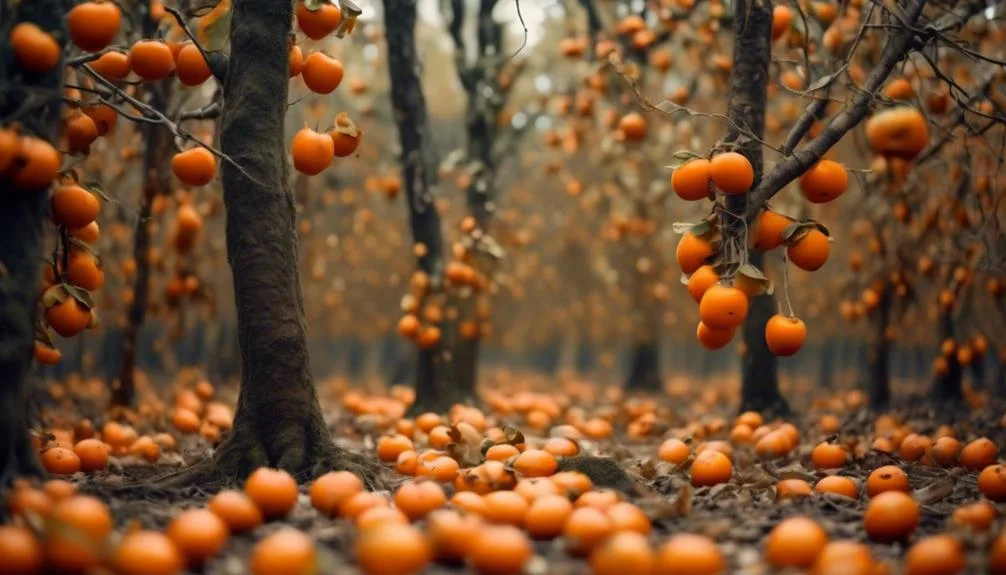Persimmon trees, known for their orange fruits and shade, are causing problems in some areas as they spread aggressively and threaten native plants and animals. Efforts are underway to control their growth.
But where exactly are persimmon trees considered invasive, and what's being done about it? Stick around to find out about the regions where persimmon trees are causing issues and the steps being taken to address the problem.
Key Takeaways
- Persimmon trees can be found in various habitats in the United States, New Zealand, Australia, South Africa, and Spain.
- Invasive persimmon trees can disrupt the balance of ecosystems and outcompete native species.
- Strategies to manage their impact include manual removal, cutting and herbicide treatments, controlled burns, promoting native species, and raising awareness.
- The preservation of persimmon trees needs to be balanced with protecting native flora and fauna in order to safeguard biodiversity and maintain the natural balance of ecosystems.
United States
In the United States, persimmon trees can be found in a variety of habitats, from forests to urban areas, and are known for their vibrant orange fruit and beautiful foliage. However, these trees can have an environmental impact when they become invasive in non-native areas.
Their ability to spread rapidly and outcompete native species can disrupt the balance of ecosystems. To manage the impact of invasive persimmon trees, various strategies are employed.
These include manual removal of young trees, cutting and herbicide treatments, and controlled burns in forested areas. Additionally, efforts are made to educate the public about the potential dangers of invasive persimmon trees and to promote the planting of native species instead.
New Zealand
Nestled amidst the lush landscapes of New Zealand, persimmon trees can be found thriving in various habitats, contributing to the country's diverse flora. These trees, originally from East Asia, were introduced to New Zealand in the 19th century and have since become naturalized in the wild. Despite their beauty and delicious fruits, persimmon trees have raised concerns due to their environmental impact. They tend to outcompete native species and can become invasive in certain areas. To manage their spread, conservationists and authorities have implemented strategies such as controlled removal and promoting the growth of native plants.
On the cultural front, persimmons hold significant traditional value in New Zealand, with their fruits being used in various culinary dishes and enjoyed as a popular treat during the autumn season.
Conservation efforts and public awareness play a crucial role in addressing the challenges posed by persimmon trees. By educating the public about the potential ecological consequences and promoting responsible planting and management practices, New Zealand aims to strike a balance between preserving its natural ecosystems and appreciating the cultural significance of persimmons. Through these combined efforts, the country hopes to ensure the long-term sustainability of both its flora and cultural traditions.
Australia
Amidst the diverse landscapes of Australia, persimmon trees have also found a home, where their naturalized presence raises concerns about their potential invasiveness and impact on native flora.
The impact of persimmon trees on biodiversity in Australia is a growing concern. These trees, originally from Asia, have been introduced to various regions in Australia for their fruit, but their ability to spread and outcompete native vegetation poses a threat to the local ecosystem. The trees can alter soil composition, affect water availability, and disrupt the natural balance of the environment.
To address this issue, management strategies such as targeted removal of invasive persimmon trees, promoting the growth of native species, and raising awareness about the impact of these trees on the environment are being implemented.
It's crucial to maintain a balance between preserving the beauty of persimmon trees and protecting Australia's native flora and fauna.
South Africa
A significant concern arises in South Africa due to the invasive presence of persimmon trees, posing a threat to the native flora and ecosystem. The environmental impact is profound, as these non-native trees outcompete indigenous vegetation, leading to a loss of biodiversity. Control measures are imperative to mitigate this threat and preserve the delicate balance of the local ecosystem.
Local wildlife is also at risk, as the invasive persimmon trees can disrupt the natural habitat of indigenous species, impacting the delicate ecosystem balance. It's crucial to address this issue promptly to safeguard the unique biodiversity of South Africa and ensure the harmony of its ecosystems.
Spain
Spain is facing a growing concern with the invasive spread of persimmon trees, posing a potential threat to the native ecosystems and biodiversity. The impact of persimmon trees on Spain's environment is significant. These trees, originally from Asia, can outcompete native species, leading to a decline in biodiversity.
Invasive persimmon trees can also alter soil composition and water availability, further disrupting the delicate balance of the ecosystem. Environmental management strategies are being employed to control the spread of persimmon trees in Spain. These include targeted removal of the trees in affected areas, as well as the promotion of native species to restore the natural balance.
It's crucial to address the invasive spread of persimmon trees in Spain to safeguard the country's unique biodiversity and preserve its native ecosystems.
Conclusion
In regions like the United States, New Zealand, Australia, South Africa, or Spain, it's important to be mindful of the potential invasiveness of persimmon trees. Before planting them, consulting local authorities is crucial to prevent unintended harm to native ecosystems.
Let's make informed choices to safeguard our environment and promote biodiversity.

